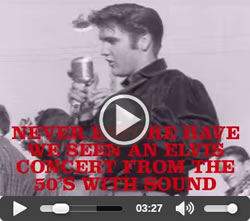Elvis At Warhol: Mama's Boy And Devil In Disguise

By Alfred Wertheimer
|
In the second, he is shirtless and leaning toward his mother, a stocky woman in a housedress, who has just handed him a pair of clean underwear. His lips brush her cheek.
The connection between these images may seem hard to reconcile until you know the identity of the man: Elvis Presley. An exhibit that opens Saturday at the Andy Warhol Museum uses these images and others to document the mix of mama's boy and devil in disguise that made him both celebrity template and cautionary tale. 'Where is Elvis? The Man and His Reflection' also offers a window into the early career of this truck driver from Memphis who changed the landscape of popular culture, music and race.
'The medium of TV and the birth of Elvis came at exactly the same time,' said John W. Smith, curator of the show, as he gave a tour of the exhibit last week. 'Before, it didn't matter as much what you looked like, with radio or records. With Elvis, it was the whole package'.
The show tells this story in 65 images from 1954 to 1967, several of them probably familiar even to those who know little about Elvis or his influence. One of the most well-known is the Roger Marshutz shot of Elvis on stage in his hometown of Tupelo, wearing a velvet shirt his mother made, reaching out to touch a furious wave of fans. (In the understatement of the show, Marshutz explains his method by saying, 'I got lucky'.) Another famed image is Marvin Israel's take on the 40-foot cutout of Elvis at the premiere of his first film, 'Love Me Tender'.
Thirty of the show's 65 photos were taken by Alfred Wertheimer, a freelancer when RCA Records asked him to take some publicity shots of a young rock 'n' roll singer. (His initial response: 'Elvis who?')
These photos have become iconic, not just for their beauty but for the narrative they capture. Wertheimer witnessed a few crucial months in Presley's career soon after the singer turned 21 in January 1956. He trailed Elvis to New York for performances on the Dorsey Brothers' 'Stage Show' in March and on Steve Allen's variety show in June, where he sang his new hit 'Hound Dog' on stage with a basset hound wearing a bow tie and top hat. He caught Elvis surrounded by hopped-up fans and unrecognized in a lunch line; he followed him home to Memphis for the Fourth of July, where he swam in his new pool and slow-danced with his high school sweetheart.
Wertheimer is a fine photographer, and in Elvis he had an ideal subject. His access is unlimited and extraordinary; the photos of Elvis kissing his date and his mother are less shocking for their content than for the fact that Elvis didn't seem to mind either of them being taken. They also reveal a key to his appeal: Presley is performing in these photos, but at the same time he gives the appearance of not performing at all. He also appears incapable of taking a lousy photograph, even when he just woke up.
Smith stopped in front of a Wertheimer print of Elvis lounging in a train berth, arm flung over his head, staring into space. 'He looks like Garbo,' Smith said. 'It's so perfectly beautiful -- incredibly androgynous'.
He is forever ready for his close-up. Shirtless after a shower, he whips his pompadour into a froth before a live gig on 'Stage Show'. (Judging from these photos, when he wasn't singing or signing autographs Elvis liked to run around half-dressed.) He loafs at a lunch counter in Richmond, the girl in the evening dress beside him, an empty cup of coffee before him. He waits in a lunch line in Sheffield, Ala., for a double order of fried chicken, milk and snow cones. He sits astride his Harley in another well-known shot, cap over his eyes, lip curled, channeling Brando in 'The Wild One'.
'But look at this,' Smith said, pointing to the cycle's chrome. What first appears to be random shadow is really the reflection of a small crowd watching and waiting for Elvis' attention. 'What seems to be a moment alone is really him surrounded by all these people'.
Those funhouse shapes seem like a foreshadowing of what was to come. The innocence and openness of the 1956 Wertheimer photos, which stop here on July 4, has faded by Sept. 9 of the same year, when Presley steps on stage to sing for Ed Sullivan. His movie career had begun, and something else had ended.
Staring down this timeline is Warhol's 'Elvis (Eleven Times),' a 1962 silkscreen that shows the singer as a gunslinger in a still from the 1960 western 'Flaming Star'. The freedom of the young man is completely gone, replaced by a silly role in a forgettable film.
'It's great we have this painting here,' Smith said. 'Warhol couldn't have necessarily foreseen where Elvis' career would have gone. But he intuited some kind of strangeness or tragedy'.
A different kind of danger is on display on the Warhol's fourth floor. 'Douglas Gordon: Blind Star,' which also opens Saturday, is a collection of Hollywood publicity stills from the 1940s and 1950s with -- there's really no other way to say this -- the eyes cut out of them. These 100 collaged photos have never been displayed anywhere before.
Gordon, a Scottish-born artist and winner of Tate Britain's Turner Prize, replaced the eyes of stars such as Cary Grant, Greta Garbo and Bette Davis with backings of white or black museum board or mirrors, and the effect is, to say the least, creepy. It's startling how some of the celebrities are hard to identify with their eyes missing, and how the replacements change them. Granted, Boris Karloff doesn't look much different staring through black holes; George Sanders is vacant yet still elegant with his herringbone jacket and stark white sockets. But seeing Debbie Reynolds beaming through mirrors is the stuff of nightmares: Tammy as a harpy from hell.
The first floor seems safer, though still vaguely sinister. 'Where Is Elvis?' ends with a single photo from 1967 of a press conference after Elvis married Priscilla. Both of them are smiling. Both of them wear pompadours that laugh at the laws of gravity. But in the stiff staging of the photo -- after all, not many couples address the press at their wedding -- it's obvious more has changed in the life of Elvis than the height of his hair. It makes you wonder what is behind his eyes.
'The Summer Of Andy'
WITH: 'Where Is Elvis?' (through Aug. 31) and 'Blind Star' (through Aug. 17). A third exhibit opening Saturday is 'Too Hot to Handle: Creating Controversy Through Political Cartoons,' curated by art historian Sylvia Rhor and Post-Gazette cartoonist Rob Rogers. This show features more than 50 American political cartoons that unsettled newspaper readers or editors who chose to censor them. It runs through Aug. 31.
© Copyright 2024 by www.elvis.com.au & www.elvispresley.com.au
![]() https://www.elvis.com.au/presley/artile-elvisatwarhol.shtml
https://www.elvis.com.au/presley/artile-elvisatwarhol.shtml
No part of any article on this site may be re-printed for public display without permission.
 Tupelo's Own Elvis Presley DVD
Tupelo's Own Elvis Presley DVD
Never before have we seen an Elvis Presley concert from the 1950's with sound. Until Now! The DVD Contains recently discovered unreleased film of Elvis performing 6 songs, including Heartbreak Hotel and Don't Be Cruel, live in Tupelo Mississippi 1956. Included we see a live performance of the elusive Long Tall Sally seen here for the first time ever. + Plus Bonus DVD Audio.
This is an excellent release no fan should be without it.
The 'parade' footage is good to see as it puts you in the right context with color and b&w footage. The interviews of Elvis' Parents are well worth hearing too. The afternoon show footage is wonderful and electrifying : Here is Elvis in his prime rocking and rolling in front of 11.000 people. Highly recommended.
Tupelo's Own Elvis Presley DVD Video with Sound.





